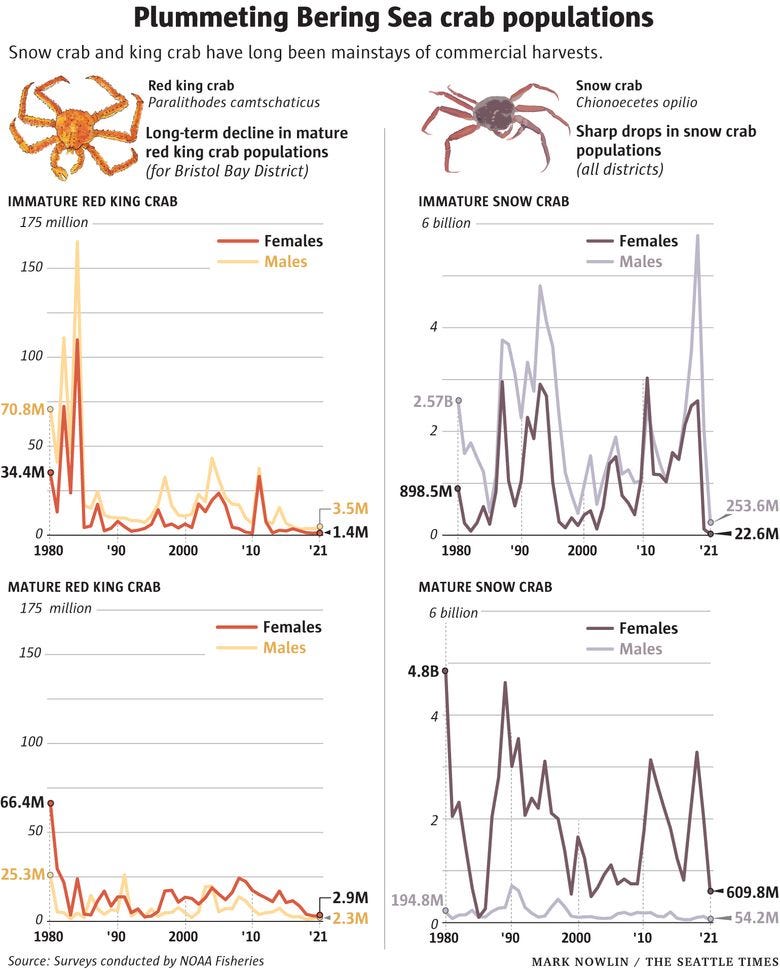Bering Sea Snow Crab: The New Poster Child for Climate Change?
Bearing the Truth: 1.1°C Atmosphere Rise ≠ 3°C Bering Sea Jump! Snow Crab & Polar Bear Myths Debunked.
Alasaka’s crab fishery…
Alaska's crab fishery has a rich and storied history. Stretching back to the early 20th century, the vast and icy waters off Alaska's coastlines have been a lucrative ground for crabbers. The most famous crab species, including the red king crab, blue king crab, golden king crab, and snow crab, are all caught in this region. The discovery of abundant crab populations in Alaska led to the introduction of modern fishing vessels and techniques. By the mid-20th century, crabbing had become a significant industry for the state.
During the 1970s and 1980s, Alaska's crab fishery experienced a boom. The perilous nature of the profession and the riches it offered led to an influx of fishermen, with boats often operating in treacherous waters to haul in the lucrative catch. This period also witnessed the growth of the Alaskan king crab industry as a household name, thanks in part to media attention and popular television shows like "Deadliest Catch."
However, with the promise of lucrative returns, overfishing became a severe concern. By the late 1980s and early 1990s, crab stocks, particularly the red king crab, began to show signs of significant decline. Conservation measures and strict regulations were put in place to ensure the sustainability of the industry.

Over the years, there have been instances when crab seasons were canceled due to low numbers, reflecting the fragile nature of the ecosystem and the susceptibility of crab populations to overfishing. The most notable season closures occurred in the early 1980s and then again in the early 2010s. Specifically, the Bristol Bay red king crab season was completely closed in 2019 due to concerns about declining crab populations.
Recently in Alaska, the Bering Sea snow crab fishery was closed for the second year due to low population levels. The Bristol Bay red king crab fishery was also closed for the 2022-2023 season but has since re-opened, and the Bering Sea blue king crab fishery was partially closed.
Such decisions, though challenging for fishermen and the industry at large, are critical to ensuring the long-term viability of crab stocks in Alaska. The closures serve as reminders of the delicate balance between human enterprise and environmental conservation.
Origin and evolution of Chionoecetes opilio…
Snow crabs, known scientifically as Chionoecetes opilio, are decapod crustaceans with roots dating back hundreds of millions of years. However, their specific evolutionary journey isn't as thoroughly documented as some terrestrial species. Found predominantly in the cold waters of the Northern Hemisphere, their distribution spans the northwest Atlantic, from Greenland to the Gulf of Maine, the northeast Atlantic around the Barents Sea, and in the North Pacific from the Sea of Japan to the Gulf of Alaska.
These crabs showcase seasonal movements largely influenced by mating needs and environmental factors. In spring and early summer, mature males venture to shallower waters for mating, returning to the depths post-mating. Their preference for colder waters, between 0°C to 6°C, also determines their movement. Juvenile snow crabs often migrate to warmer, shallow waters during the summer to molt and grow, retreating to deeper waters as they age.
Snow crab populations can collapse for a variety of reasons, including:
Overfishing: Snow crabs are a valuable commercial species, and overfishing can lead to population declines.
Climate change: Changes in water temperatures can stress snow crabs and make them more susceptible to disease.
Habitat loss: Snow crabs rely on sea ice for protection and for breeding. Habitat loss can also contribute to population declines.
Disease: Snow crabs are susceptible to a variety of diseases, including some that are caused by parasites. Disease outbreaks can lead to mass mortalities and population collapses.
Predation: Snow crabs are preyed upon by a variety of predators, including fish, birds, and marine mammals. Increased predation pressure can also contribute to population declines.
Regarding the recent snow crab collapse in the Bering Sea, scientists believe that a combination of factors, including overfishing, warming waters due to climate change, and disease, were likely responsible.
The widespread distribution and commercial significance of snow crabs emphasizes the importance of understanding their behavior and patterns for sustainable management.
Cause of recent collapse…
Keep reading with a 7-day free trial
Subscribe to Irrational Fear to keep reading this post and get 7 days of free access to the full post archives.




